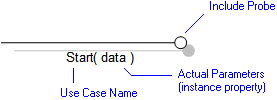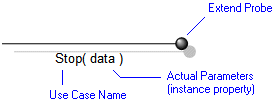




 on the Use Case's icon indicates that the item is a
stub.
on the Use Case's icon indicates that the item is a
stub.If you select the UML\Use Cases folder in the Dictionary pane, the Contents pane displays the following information about each Use Case in the model: Name, Initial Event, Visibility, Package, Changed By and Changed On. |
 Dependency — The Dependency is owned jointly by the Use Case and the other associated item. The access permissions you have to a Dependency are determined by the access permissions of the dependent item.
Dependency — The Dependency is owned jointly by the Use Case and the other associated item. The access permissions you have to a Dependency are determined by the access permissions of the dependent item. Generalization — The Generalization is owned jointly by the Use Cases it links. The access permissions you have to a Generalization are determined by the access permissions you have to the child Use Case.
Generalization — The Generalization is owned jointly by the Use Cases it links. The access permissions you have to a Generalization are determined by the access permissions you have to the child Use Case. Activity — The linked Activity specifies the behavior that is invoked when you create an instance of the Use Case, that is, classifier behavior. The linked Activity must be owned by the Use Case, either directly or indirectly through inheritance. This link can be made through the Classifier Behaviors association on the Items tab of the Use Case's Property Pages.
Activity — The linked Activity specifies the behavior that is invoked when you create an instance of the Use Case, that is, classifier behavior. The linked Activity must be owned by the Use Case, either directly or indirectly through inheritance. This link can be made through the Classifier Behaviors association on the Items tab of the Use Case's Property Pages. Actor — The linked Actor performs or exchanges information with the Use Case. This link can be made by linking the items on a Use Case Diagram.
Actor — The linked Actor performs or exchanges information with the Use Case. This link can be made by linking the items on a Use Case Diagram. Atomic State — through the states relationship.
Atomic State — through the states relationship. Concurrent State — - through the states relationship.
Concurrent State — - through the states relationship. Entry State — through the states relationship.
Entry State — through the states relationship. Exit State — through the states relationship.
Exit State — through the states relationship. Final State — through the states relationship.
Final State — through the states relationship. Fork State — through the states relationship.
Fork State — through the states relationship. History State — through the states relationship.
History State — through the states relationship. Increment — The Use Case is delivered by the linked Increment.
Increment — The Use Case is delivered by the linked Increment. Initial State — through the states relationship.
Initial State — through the states relationship. Join State — through the states relationship.
Join State — through the states relationship. Junction State — through the states relationship.
Junction State — through the states relationship. Sequential State — through the states relationship.
Sequential State — through the states relationship. State Machine — The linked State Machine specifies the behavior that is invoked when you create an instance of the Use Case, that is, classifier behavior. The linked State Machine must be owned by the Use Case, either directly or indirectly through inheritance. This link can be made through the Classifier Behaviors association on the Items tab of the Use Case's Property Pages.
State Machine — The linked State Machine specifies the behavior that is invoked when you create an instance of the Use Case, that is, classifier behavior. The linked State Machine must be owned by the Use Case, either directly or indirectly through inheritance. This link can be made through the Classifier Behaviors association on the Items tab of the Use Case's Property Pages. Submachine State — through the states relationship.
Submachine State — through the states relationship.Like most other items in a Model, a Use Case can be linked to an
Activity Partition,
Comment,
Frame Box,
General Node,
General Flow,
General Flow Diagram Node,
Constraint (applied),
General Flow Diagram Flow or
Swimlane. |